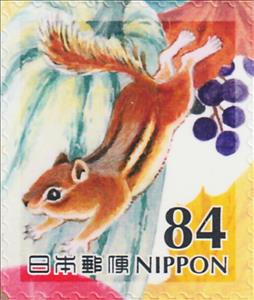Stamp: Chipmunk (Japan 2019)
Chipmunk (Japan 2019)
23 August (Japan ) within release Greetings: Autumn 2019 goes into circulation Stamp Chipmunk face value 84 Japanese yen
| Stamp Chipmunk in catalogues | |
|---|---|
| Michel: | Mi: JP 9818 |
| Colnect codes: | Col: JP 2019-26Bf |
Stamp is square format.
stamp from booklet paneAlso in the issue Greetings: Autumn 2019:
- Stamp - Squirrel and Pine Cone face value 63;
- Stamp - Chipmunk face value 84;
- Stamp - Pine Cone and Juniper Berries face value 63;
- Booklet Pane - Autumn Greetings face value 10*84;
- Stamp - Fruit and Mouse face value 84;
- Stamp - Flowers face value 84;
- Stamp - Mushrooms face value 84;
- Stamp - Pine Cones face value 63;
- Stamp - Apple and Flower face value 84;
- Stamp - Nuts face value 63;
- Stamp - Gourd and Mouse face value 84;
- Stamp - Autumn Leaves face value 84;
- Stamp - Cardinal and Fruits face value 84;
- Stamp - Pine Cone face value 63;
- Stamp - Pine Cone face value 63;
- Stamp - Fruits face value 84;
- Stamp - Bird and Acorns face value 63;
- Stamp - Squirrel face value 63;
- Stamp - Bird and Pine Cone face value 63;
- Stamp - Fruits face value 84;
- Stamp - Flowers face value 63;
- Booklet Pane - Autumn Greetings face value 10*63;
Stamp Chipmunk it reflects the thematic directions:
Animals are multicellular, eukaryotic organisms of the kingdom Animalia (also called Metazoa). All animals are motile, meaning they can move spontaneously and independently, at some point in their lives. Their body plan eventually becomes fixed as they develop, although some undergo a process of metamorphosis later on in their lives. All animals are heterotrophs: they must ingest other organisms or their products for sustenance.
In botany, a fruit is the seed-bearing structure in flowering plants (also known as angiosperms) formed from the ovary after flowering. Fruits are the means by which angiosperms disseminate seeds. Edible fruits, in particular, have propagated with the movements of humans and animals in a symbiotic relationship as a means for seed dispersal and nutrition; in fact, humans and many animals have become dependent on fruits as a source of food. Accordingly, fruits account for a substantial fraction of the world's agricultural output, and some (such as the apple and the pomegranate) have acquired extensive cultural and symbolic meanings. In common language usage, "fruit" normally means the fleshy seed-associated structures of a plant that are sweet or sour, and edible in the raw state, such as apples, bananas, grapes, lemons, oranges, and strawberries. On the other hand, in botanical usage, "fruit" includes many structures that are not commonly called "fruits", such as bean pods, corn kernels, tomatoes, and wheat grains. The section of a fungus that produces spores is also called a fruiting body.


